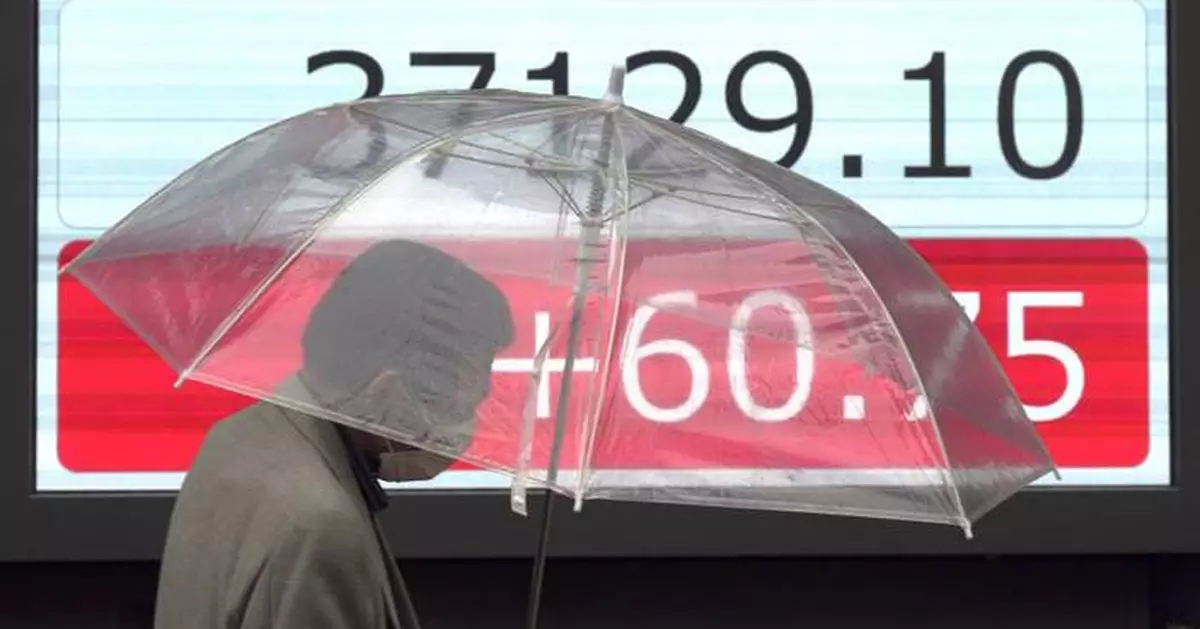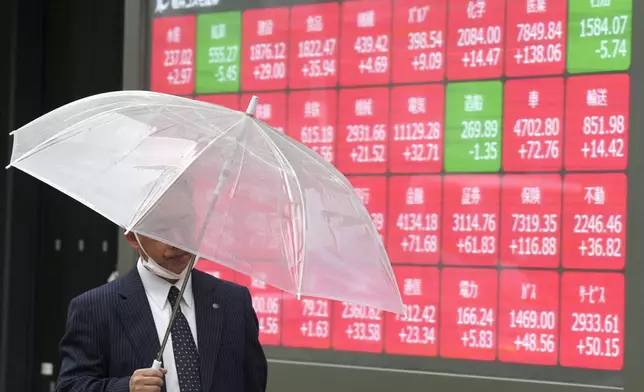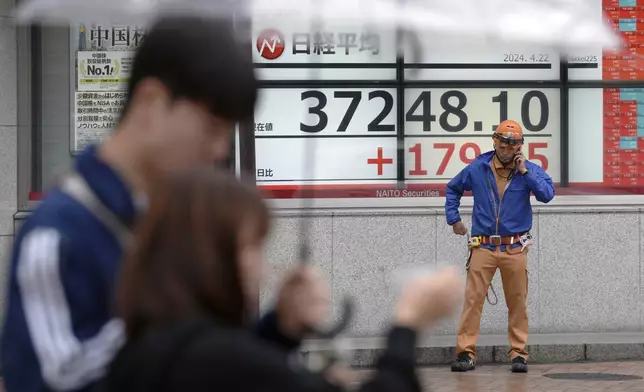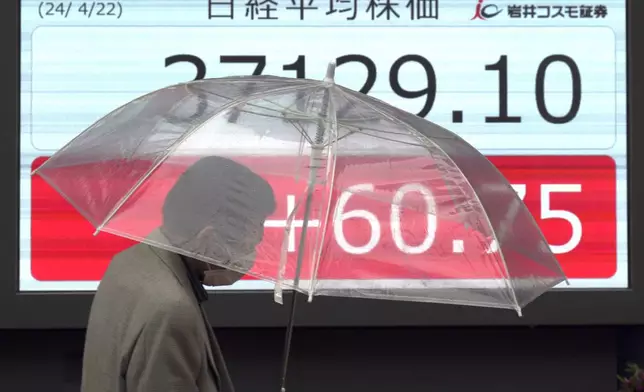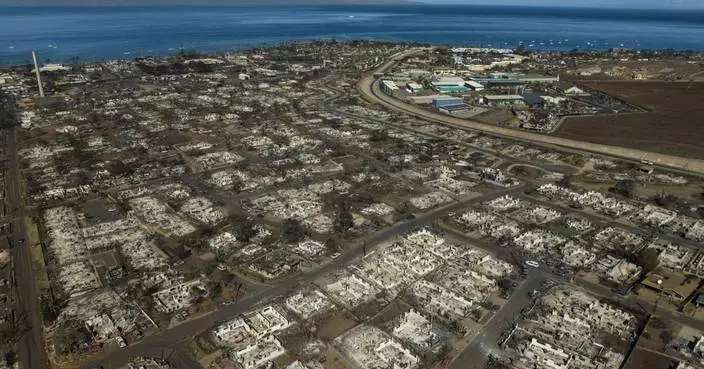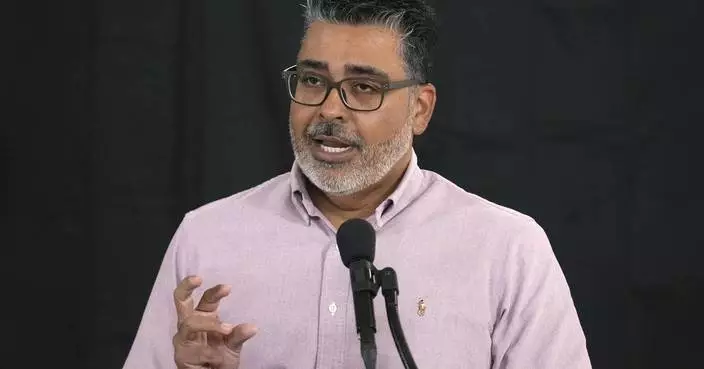HONG KONG (AP) — Asian benchmarks extended gains Tuesday after U.S. stocks clawed back a chunk of their losses from last week, which was the worst for the S&P 500 in more than a year, while the yen weakened further to fresh 34-year lows.
U.S. futures were mixed and oil prices rose.
Click to Gallery
HONG KONG (AP) — Asian benchmarks extended gains Tuesday after U.S. stocks clawed back a chunk of their losses from last week, which was the worst for the S&P 500 in more than a year, while the yen weakened further to fresh 34-year lows.
FILE - A person looks at an electronic stock board showing Japan's Nikkei 225 index at a securities firm in Tokyo, on April 19, 2024. Asian benchmarks extended gains Tuesday, April 23, after U.S. stocks clawed back a chunk of their losses from the previous week.(AP Photo/Eugene Hoshiko, File)
People pass the New York Stock Exchange, right, on Wednesday, April 17, 2024 in New York. Global shares are trading mixed after most U.S. stocks slipped on firmer expectations that the Fed is committed to its current rate practices.(AP Photo/Peter Morgan)
A person walks in front of an electronic stock board showing Japan's Nikkei 225 index at a securities firm Monday, April 22, 2024, in Tokyo. (AP Photo/Eugene Hoshiko)
A person stands in front of an electronic stock board showing Japan's Nikkei 225 index at a securities firm Monday, April 22, 2024, in Tokyo. (AP Photo/Eugene Hoshiko)
A person walks in front of an electronic stock board showing Japan's Nikkei 225 index at a securities firm Monday, April 22, 2024, in Tokyo. (AP Photo/Eugene Hoshiko)
Japan’s benchmark Nikkei 225 edged 0.1% higher to 37,471.73, despite the country's manufacturing activity contracting for 11 straight months while approaching the break-even point in April as PMI came in at 49.9, according to Tuesday figures from au Jibun bank. The yen weakened further with it hitting a fresh 34-year low of 154.85 early Tuesday.
The Hang Seng in Hong Kong added 1.2% to 16,715.15 while the Shanghai Composite index was down 0.6% at 3,025.76.
Australia’s S&P/ASX 200 climbed 0.4% to 7,677.40. South Korea’s Kospi dropped less than 0.1% to 2,628.14.
On Monday, the S&P 500 rose 0.9% to 5,010.60 to recover more than a quarter of last week’s rout. The Dow Jones Industrial Average added 0.7% to 38,239.98, and the Nasdaq composite jumped 1.1% to 15,451.31.
The rally was widespread, and most stocks across Wall Street rose. In the S&P 500, technology stocks led the way to bounce back from their worst week since the COVID crash of 2020.
Nvidia leaped 4.4%, and Alphabet climbed 1.4% as Treasury yields stabilized in the bond market. Last week, a jump in yields cranked up the pressure on stocks, particularly those seen as the most expensive and making their investors wait the longest for big growth.
Bank stocks were also strong following some encouraging profit reports. Truist Financial rallied 3.4% after its profit for the start of the year topped analysts’ expectations.
They helped offset a 3.4% drop for Tesla, which announced more cuts to prices over the weekend. Elon Musk’s electric vehicle company has seen its stock drop more than 40% already this year, and it will report its first-quarter results later in the day.
It’s a big week for earnings reports generally, with roughly 30% of the companies in the S&P 500 scheduled to say how much they made during the year’s first three months. That includes companies that have come to be known as part of the “Magnificent Seven,” beyond Tesla and Alphabet.
The difference in growth between the Magnificent Seven and the rest of the S&P 500 should close by the end of the year, strategists Ohsung Kwon and Savita Subramanian said in a BofA Global Research report.
Verizon Communications helped kick off this week’s reports by disclosing a drop in profit that wasn’t as bad as analysts expected. It cited price increases and other measures to support its revenue. Verizon’s stock swung from an early gain to a loss of 4.7% after it reported weaker revenue for the first quarter than expected and kept its forecast for full-year profit the same.
Even more pressure than usual is on companies broadly to deliver fatter profits and revenue. That’s because the other big factor that sets stock prices, interest rates, looks unlikely to offer much help in the near term.
Top officials at the Federal Reserve warned last week that they may need to keep interest rates high for a while in order to ensure inflation is heading down to their 2% target. That was a big letdown for financial markets, dousing hopes that had built after the Fed signaled earlier that three interest-rate cuts may come this year.
Lower rates had appeared to be on the horizon after inflation cooled sharply last year. But a string of reports this year showing inflation has remained hotter than expected has raised worries about stalled progress.
In oil trading, U.S. benchmark crude picked up 32 cents to $82.22 per barrel. Brent crude, the international standard, gained 30 cents to $87.30 per barrel.
The U.S. dollar slipped to 154.75 Japanese yen from 154.84 yen. The euro rose to $1.0656 from $1.0653.
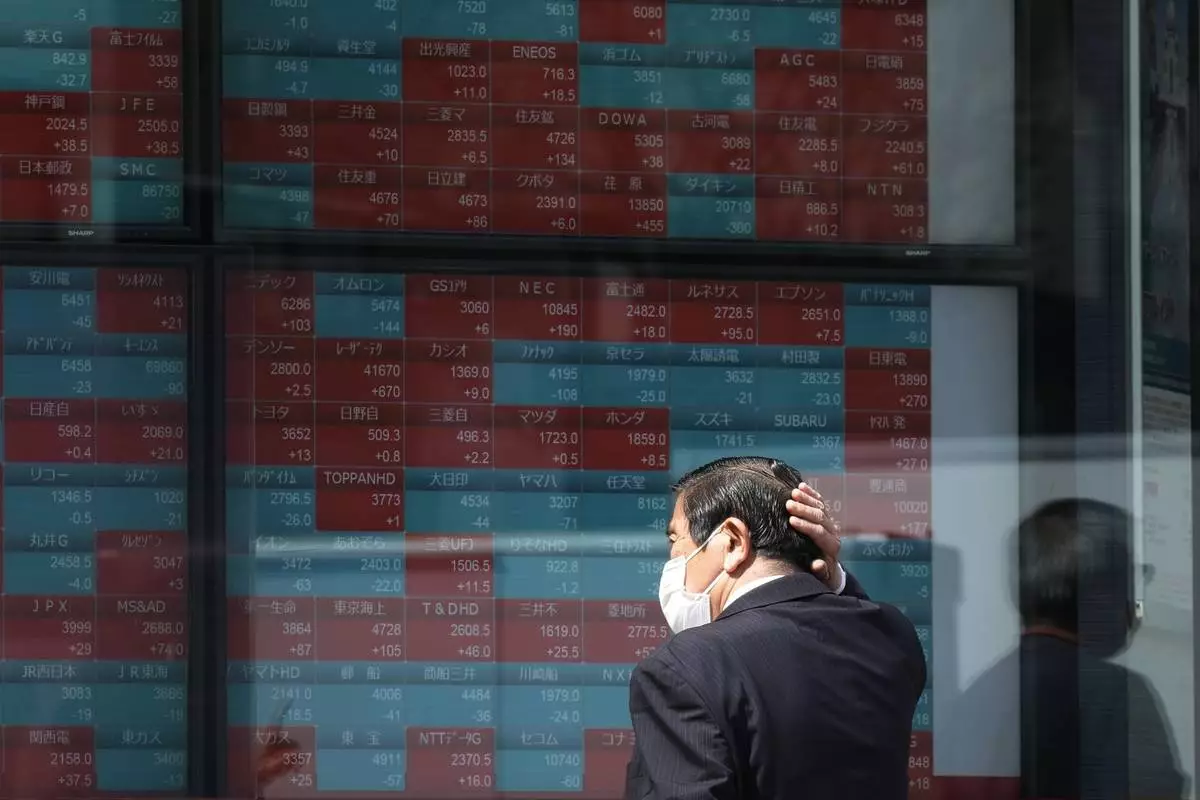
FILE - A person looks at an electronic stock board showing Japan's stock princes at a securities firm in Tokyo, April 2, 2024. Asian benchmarks extended gains Tuesday, April 23, after U.S. stocks clawed back a chunk of their losses from the previous week. (AP Photo/Eugene Hoshiko, File)
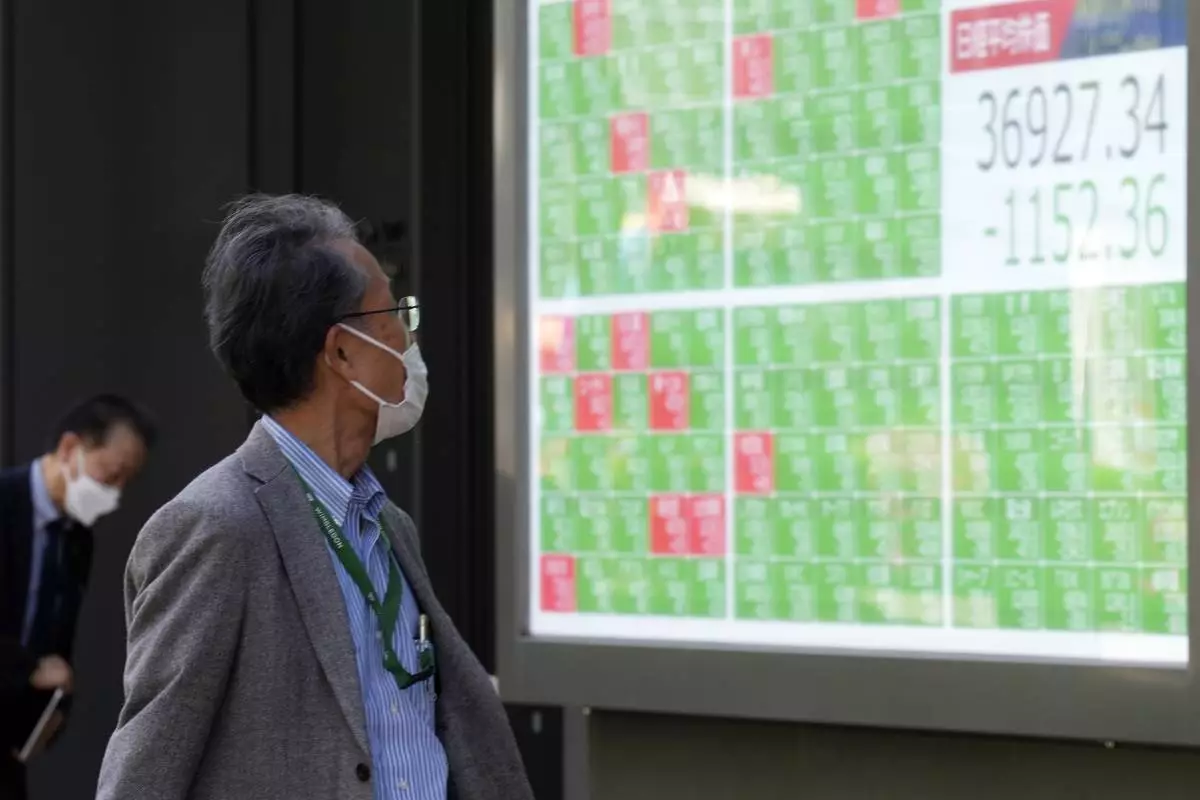
FILE - A person looks at an electronic stock board showing Japan's Nikkei 225 index at a securities firm in Tokyo, on April 19, 2024. Asian benchmarks extended gains Tuesday, April 23, after U.S. stocks clawed back a chunk of their losses from the previous week.(AP Photo/Eugene Hoshiko, File)
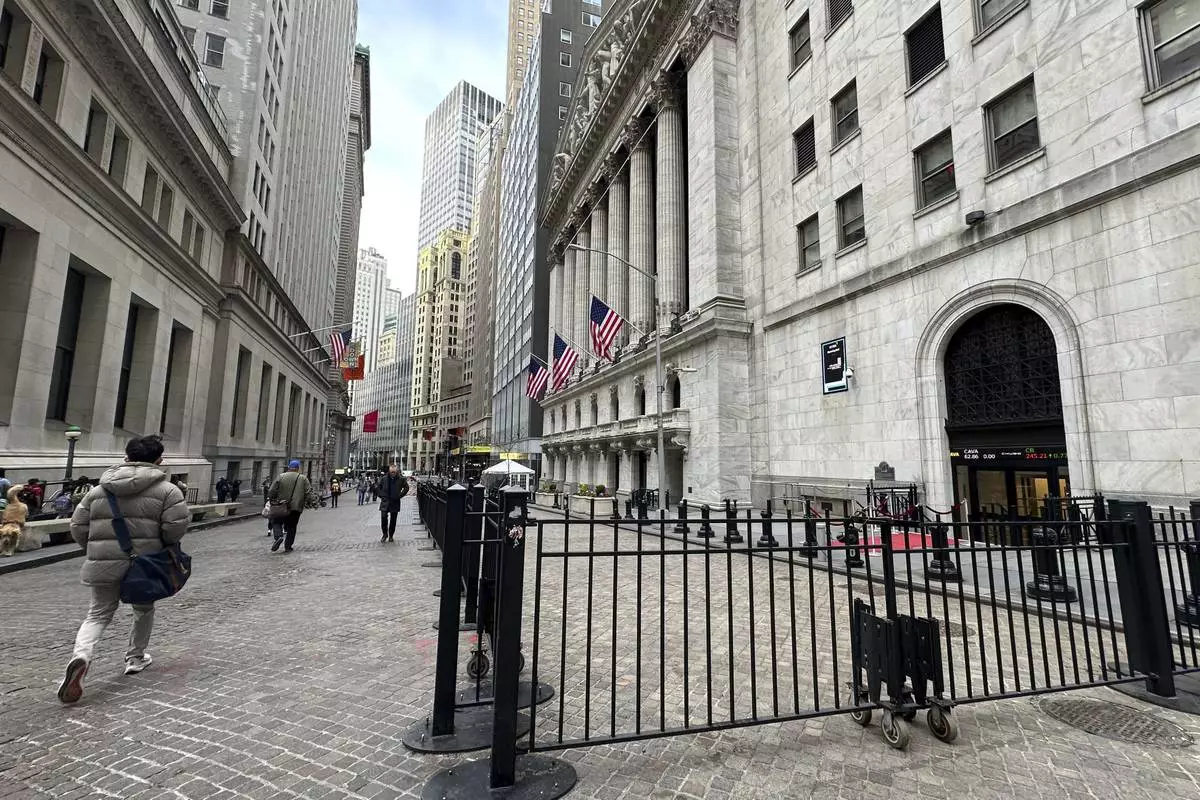
People pass the New York Stock Exchange, right, on Wednesday, April 17, 2024 in New York. Global shares are trading mixed after most U.S. stocks slipped on firmer expectations that the Fed is committed to its current rate practices.(AP Photo/Peter Morgan)

A person walks in front of an electronic stock board showing Japan's Nikkei 225 index at a securities firm Monday, April 22, 2024, in Tokyo. (AP Photo/Eugene Hoshiko)

A person stands in front of an electronic stock board showing Japan's Nikkei 225 index at a securities firm Monday, April 22, 2024, in Tokyo. (AP Photo/Eugene Hoshiko)

A person walks in front of an electronic stock board showing Japan's Nikkei 225 index at a securities firm Monday, April 22, 2024, in Tokyo. (AP Photo/Eugene Hoshiko)
WASHINGTON (AP) — A top U.N. official said Friday that hard-hit northern Gaza was now in “full-blown famine" after more than six months of war between Israel and Hamas and severe Israeli restrictions on food deliveries to the Palestinian territory.
Cindy McCain, the American director of the U.N. World Food Program, became the most prominent international official so far to declare that trapped civilians in the most cut-off part of Gaza had gone over the brink into famine.
“It’s horror," McCain told NBC's “Meet the Press” in an interview to air Sunday. “There is famine — full-blown famine — in the north, and it’s moving its way south."
She said a cease-fire and a greatly increased flow of aid through land and sea routes was essential to confronting the growing humanitarian catastrophe in Gaza, ilhome to 2.3 million people.
There was no immediate comment from Israel, which controls entrance into Gaza and says it is beginning to allow in more food and other humanitarian aid through land crossings.
The panel that serves as the internationally recognized monitor for food crises said earlier this year that northern Gaza was on the brink of famine and likely to experience it this month. The next update will not come before this summer.
One of the U.S. Agency for International Development's humanitarian officials in Gaza told The Associated Press that on-the-ground preparations for a new U.S.-led sea route were on track to bring in more food — including treatment for hundreds of thousands of starving children — by early or mid-May. That's when the American military expects to finish building a floating pier to receive the shipments.
Ramping up the delivery of aid on the planned U.S.-backed sea route will be gradual as aid groups test the distribution and security arrangements for relief workers, the USAID official said.
The official spoke on condition of anonymity over security concerns for work done in a conflict zone. They were some of the agency’s first comments on the status of preparations for the Biden administration’s $320 million Gaza pier project, for which USAID is helping coordinate on-the-ground security and distribution.
At a factory in rural Georgia on Friday, USAID Administrator Samantha Power pointed to the food crises in Gaza and other parts of the world as she announced a $200 million investment aimed at increasing production of emergency nutritional paste for starving children under 5.
Power spoke to factory workers, peanut farmers and local dignitaries sitting among pallets of the paste at the Mana nonprofit in Fitzgerald. It is one of two factories in the U.S. that produces the nutritional food, which is used in clinical settings and made from ground peanuts, powdered milk, sugar and oil, ready to eat in plastic pouches resembling large ketchup packets.
“This effort, this vision meets the moment,” Power said. "And it could not be more timely, more necessary or more important.”
Under pressure from the U.S. and others, Israeli officials in recent weeks have begun slowly reopening some border crossings for relief shipments.
But aid coming through the sea route, once it's operational, still will serve only a fraction — half a million people — of those who need help in Gaza. Aid organizations including USAID stress that getting more aid through border crossings is essential to staving off famine.
Children under 5 are among the first to die when wars, droughts or other disasters curtail food. Hospital officials in northern Gaza reported the first deaths from hunger in early March and said most of the dead were children.
Power said the U.N. has called for 400 metric tons of the nutritional paste “in light of the severe hunger that is pervading across Gaza right now, and the severe, acute humanitarian crisis.” USAID expects to provide a quarter of that, she said.
Globally, she said at the Georgia factory, the treatment made there “will save untold lives, millions of lives.”
USAID is coordinating with the World Food Program and other humanitarian partners and governments on security and distribution for the pier project, while U.S. military forces finish building it. President Joe Biden, under pressure to do more to ease the humanitarian catastrophe in Gaza as the U.S. provides military support for Israel, announced the project in early March.
U.S. Central Command said in a statement Friday that offshore assembly of the floating pier has been temporarily paused due to high winds and sea swells, which caused unsafe conditions for soldiers. The partially built pier and the military vessels involved have gone to Israel's Port of Ashdod, where the work will continue.
A U.S. official said the high seas will delay the installation for several days, possibly until later next week. The official, who spoke on condition of anonymity to discuss operation details, said the pause could last longer if the bad weather continues because military personnel and divers have to get into the water for the final installation.
The struggles this week with the first aid delivery through a newly reopened land corridor into north Gaza underscored the uncertainty about security and the danger still facing relief workers. Israeli settlers blocked the convoy before it crossed Wednesday. Once inside Gaza, the convoy was commandeered by Hamas militants, before U.N. officials reclaimed it.
In Gaza, the nutritional treatment for starving children is most urgently needed in the northern part of the Palestinian territory. Civilians have been cut off from most aid supplies, bombarded by Israeli airstrikes and driven into hiding by fighting.
Acute malnutrition rates there among children under 5 have surged from 1% before the war to 30% five months later, the USAID official said. The official called it the fastest such climb in hunger in recent history, more than in grave conflicts and food shortages in Somalia or South Sudan.
One of the few medical facilities still operating in northern Gaza, Kamal Adwan hospital, is besieged by parents bringing in thousands of children with malnutrition for treatment, the official said. Aid officials believe many more starving children remain unseen and in need, with families unable to bring them through fighting and checkpoints for care.
Saving the gravely malnourished children in particular requires both greatly increased deliveries of aid and sustained calm in fighting, the official said, so that aid workers can set up treatment facilities around the territory and families can safely bring children in for the sustained treatment needed.
Bynum reported from Fitzgerald, Georgia. Associated Press writers Lolita C. Baldor in Washington and Edith M. Lederer at the United Nations contributed.

USAID Administrator Samantha Power speaks with U.S. Rep. Austin Scott on Friday, May 3, 2024, during a tour of the factory where the nonprofit Mana produces emergency nutritional aid in Fizgerald, Ga. Power announced USAID is investing $200 million in emergency food aid for children in Gaza, Sudan and other countries where conflict has driven up need. AP Photo by Russ Bynum Sent from my iPhone

USAID Administrator Samantha Power talks with a worker Friday, May 3, 2024, during a tour of the factory where the nonprofit Mana makes emergency nutritional aid in Fitzgerald, Georgia. Power announced USAID is investing $200 million in emergency nutritional treatment for starving children as conflicts in Gaza, Sudan and elsewhere drive up the need. (AP Photo/Russ Bynum)

USAID Administrator Samantha Power talks with Mana operations director Harry Broughton during a tour of its factory in Fitzgerald, Ga., that produces emergency nutritional aid for starving children, on Friday, May 3, 2024. Power announced USAID is investing $200 million to increase nutritional aid for starving children in Gaza, Sudan and other places where conflict has increased needs. (AP Photo/Russ Bynum)

In this image provided by the U.S. Army, soldiers assigned to the 7th Transportation Brigade (Expeditionary) and sailors attached to the MV Roy P. Benavidez assemble the Roll-On, Roll-Off Distribution Facility (RRDF), or floating pier, off the shore of Gaza on April 26, 2024. The U.S. expects to have on-the-ground arrangements in Gaza ready for humanitarian workers to start delivering aid this month via a new U.S.-backed sea route for Gaza aid. An official with the U.S. Agency for International Development tells the AP that humanitarian groups expect to have their part of preparations complete by early to mid-month. (U.S. Army via AP)








